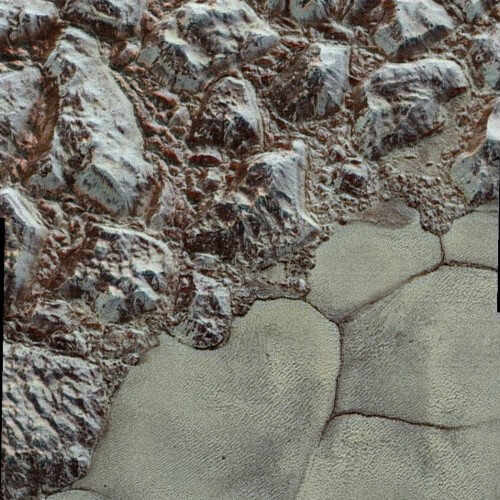The enhanced color image composite includes some of the sharpest views of Pluto taken by the New Horizons spacecraft during its July 14 flyby.

An enhanced color image supplement includes some of the sharpest views of Pluto taken by the New Horizons spacecraft during its July 14 flyby.
The images are part of a series of images taken around New Horizons' closest point to Pluto, and their resolution is 77-85 meters per pixel, so relatively small details can be seen. Low resolution data - about 630 meters per pixel was added to the composite to create a new image.
The width of the landscape in the picture is about 80 kilometers from the edge of the badlands northeast of what is today formally known as Sputnik Planum, and crosses the El Idrisi mountains, to the "coastline" of the "Heart" formation of Pluto, and to the ice plains of the heart.
The images that make up the composite image were taken by the Long Range Telescope (LORRI) about 15 minutes before New Horizons reached its closest point to Pluto at a distance of about 17 thousand kilometers, with color data (near infrared, red and blue) taken by Ralph/Multispectral Visible Imaging Camera (MVIC) 25 minutes before Lori's shots.
The wide variety of mountain craters and ice plains seen in the photographs provides scientists and the general public with a window into the breathtaking high-resolution landscapes of Pluto.
For information on the NASA website
The stream of images from Pluto will continue next year, when the New Horizons spacecraft will transfer all the information stored in its computer to Earth.
It is possible that her abilities will be put to further use. According to Wikipedia, on January 1, 2019 the spacecraft is expected to pass by a body in the Kuiper belt with a diameter of about 30-45 kilometers which it named 2014 MU69. The mission requires final approval from NASA in 2016, but maneuvers to correct New Horizons' orbit were already made in October 2015. In 2026, the probe is expected to finish its mission.
More of the topic in Hayadan:
- NASA has released spectacular new images from New Horizons' approach to Pluto
- Surprising discovery: New Horizons photographed young mountains on Pluto and Charon
- New Horizons photographed the frozen plains inside the "heart" of Pluto
- Pluto continues to surprise and show similarities to Earth
- Prof. Zvi Piran to the Hidaan website: "The solar system was lucky during its formation to receive an excess of heavy elements from the close merger of neutron stars"

2 תגובות
Beautiful. Those who thought that the study of the solar system was exhausting themselves, such discoveries come back and prove that the revealed is greater than the hidden.
It would be nice if in the future there would be an article about the Kuiper Belt and the story with Pluto turning from a planet to a planet-like one. It is interesting to what extent the influence of the sun's radiation touched in the creation of a structure of protective objects - the first belt is at least 2 times the distance to the farthest planet in the solar system than the sun, and the second belt - after which they are still being searched. And how the Earth, which is relatively close to the Sun, protects itself from radiation that produces a crust of asteroids and planet-like stars twice as far as the farthest planet from the Sun.
How beautiful, the first time I see color pictures from a distant planet (usually it's in black and white).
Are these the colors we will see if we are there?